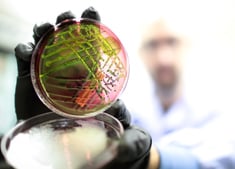Single and Multilocus Sequence Typing
In addition to sequence-based microbial identification services, we offer single locus strain typing (SLST) and multilocus sequence typing (MLST) of bacteria - both of which are sequence-based strain typing methods. When production facilities experience microbial contamination, it becomes a priority to determine the source.
In developing our strain typing solution, we connected with our QC pharmaceutical customers to discover exactly what they were searching for:
- A strain typing methodology that was validated, ensuring reliable and reproducible results
- Comprehensive understanding of microbial strains, for detailed strain comparisons and tracking evolutionary changes
- High throughput processing of samples, enabling scalability, faster turnaround times, easily interpreted reports
In response to this feedback, our team built a service that covered all these requests which resulted in a service providing:
- Robust strain differentiation, by analyzing specific genetic loci within a microbial genome, detecting unique sequence types
- Valuable insights into strain relatedness, even permitting the retrospective comparison of sequence data in the event of reoccurring species excursions
- Easy data sharing and collaboration, fostering a global network of researchers working towards a common goal
Accugenix Fungal and Bacterial Strain Typing (MLSA and MLST/SLST)
Accugenix strain typing is a microbial characterization process used to distinguish members of the same species to the strain level by utilizing well-established, highly accurate, sequencing methods.
While our methods for identification of bacteria and fungi use the 16S rRNA and ITS2 gene regions, our strain typing services sequence protein coding genes to characterize isolates to the strain level. These sequencing targets contain more variability in their sequence than the 16S or ITS2 rDNA region, thus, can be used to distinguish between strains.
The resulting DNA sequences, or sequence types, are compared to each other and the relationships displayed in a phylogenetic tree. We then perform comparisons for any samples or sets of samples upon request. In addition, when an external multilocus sequence typing database is available for the specific species tested, the sequences of each fragment are compared with all previously identified sequences at that locus and thereby, are assigned allele numbers at each of the tested loci. The combination of these allele numbers defines the allelic profile of the strain, and each different allelic profile is assigned a sequence type (ST), which is used to describe the strain.
Given the increased reproducibility of sequence-based strain typing methods which are based on the information obtained from individual sequences of species-specific protein-coding genes, they can help determine if your probiotic strains are indistinguishable or if the isolates recovered from one area of a manufacturing facility are indistinguishable or different from another isolate—an important trait that allows for high resolution and greater confidence in your tracking and trending projects over time compared to methods utilizing fragment-based analysis.
-
Why outsource single locus and multilocus sequence typing services using Accugenix strain ID?
- DNA sequence data serve as primary resources for tracking and documenting the genetic relationship of bacteria and fungi on a global scale
- DNA sequence-based strain typing results are easily cataloged and referenced for future comparisons
- MDNA sequence-based techniques are highly reproducible, unambiguous, and scalable
- Short turnaround times

Accugenix Strain Typing Case Study – Available for a limited time
Learn how Accugenix Strain Typing was used to facilitate a contamination investigation at a dietary supplement and beverage manufacturing company.
Get the full story
-
Using Fungal and Bacterial Strain Typing to Respond to a Contamination If a Sterility Failure Occurs
If a sterility failure occurs, customers can send samples to us, and we can assist in determining the root cause by analyzing sequence similarity. We will first identify the isolates by 16S or ITS2 rDNA sequencing. If the 16S/ITS2 sequence is different, you can be sure that the isolates are different strains. Further characterization is necessary for those isolates that have identical 16S or ITS2 sequences and can be done using sequence-based strain typing methods. This strain typing technology is designed to deliver the most informative data and can obtain an unambiguous result from all strains within a species.
Our MLST and SLST sequence-based strain typing can help you map your microbial environment. We can create a library database of sequences from the microorganisms found in your manufacturing environment. When a contaminant is encountered, you can quickly pinpoint where you have seen that strain before. This greatly reduces the time and cost associated with determining the source of contamination.
-
Researching Species to Find Specific Gene Targets for Higher Resolution Results
To achieve a higher degree of resolution, our R&D team searches for published data on individual species to determine the gene targets that have a higher degree of variability in their sequence than the 16S or ITS2 rDNA region and that will definitively resolve isolates of the species at the strain level. The number and identity of these loci vary for each species, due to the level of relatedness and rate of evolution within each group.

Interpreting a Strain Typing Report
Gain a thorough understanding of how to interpret strain typing results
Get the Guide

Is Your Organism of Interest on the Accugenix Strain ID Validated Method List?
Acholeplasma laidlawii to Yarrowia lipolytica, each species investigated by our team is validated and listed. New species may also be developed and validated on request.
Find Out
In addition, if a validated MLST scheme isn't available, or if it fails, Accugenix Whole Genome Sequencing Services may provide strain-level characterization.
MLST/SLST Sequence-based Strain Typing Methods
Microbial identification using the 16S and ITS rRNA regions is a robust technology. However, there are times when additional information is needed, and it is essential to be able to differentiate organisms below the species level. Increased discrimination at the strain level can be achieved by sequencing, analyzing, and comparing highly variable but sufficiently conserved loci (regions) in the organism's genome.
Single locus and multilocus sequence typing analyze essential protein coding genes, or housekeeping genes, that encode for proteins necessary for the normal cellular function of the microorganism. All of which contain more variability in their sequences than for bacterial or fungal identification used target regions 16S rRNA and ITS.
After extracting DNA from the sample, which can be viable or non-viable, the first step in the process is an accurate ID to the species level. This must be performed before starting strain typing to determine appropriate targets and primer sets as the target genes will not be the same for each species being characterized.
The target genes are PCR amplified using the gene-specific primers and subjected to comparative DNA sequence analysis. All the sequences from each gene target are concatenated (placed end-to-end), aligned, and compared to the other sequence data. The level of divergence or conservation between the organisms is calculated and displayed with a phylogenetic tree. With Accugenix Strain Typing (SLST and MLST), we will interpret the data for you and state whether the isolates are indistinguishable by sequencing of the gene targets or whether the isolates are different sequence types. If a whole perspective is needed, Accugenix Strain Typing (SLST and MLST) can be used. With this test, the sequences from each gene region are compared to public databases, the allele numbers assigned, and the strain typing number determined.
SPECIFICATIONS
-
Order Code
Turnaround Time (TAT) Test Code 5 Days AccuGENX-ST-5 5 Days AccuGENX-XGST-5 Inquire MLST Assay Development Fee
Frequently Asked Questions About Accugenix Strain Typing (SLST and MLST)
-
How do you select the right strain typing technology?
There are a number of technologies that compare isolates of the same species down to the strain level. Whether just a few genes should be sequenced, if a validated multilocus sequence typing scheme isn't available, or if deeper resolution is required, it can be challenging to figure out exactly what you need to achieve your desired outcome. Our experts are available to discuss your specific situation and recommend the appropriate test.
-
What is the difference between a microbial species and a strain?
A species is a group of strains that are genetically very similar, whereas strains have unique genetic sequences. Taxonomists use strain types to represent and define the DNA sequence of a species, but there is genetic diversity within a species, which are called strains. Learn more about the bacterial species concept.
-
What is the difference between microbial identification and strain typing?
Identification determines if an unknown isolate belongs to a specific taxonomic rank, and results in the assignment of a name. Strain typing is a comparative analysis and determines how isolates are related to each other based on sequence information. Our Accugenix ID services perform genotypic microbial identification by DNA sequencing of the conserved 16S rRNA gene in bacteria and IT2 region in fungi. The identification is made based on phylogenetic analysis and can only resolve down to the species level. Because members of the same species can still have genetic diversity, strain typing can be achieved by sequencing other highly variable genetic loci. The resulting data will convey whether isolates are different from each other or indistinguishable.
-
What is the difference between basic multilocus sequence typing and multilocus sequence typing with strain typing?
While both tests are used for strain typing, multilocus sequence typing with ST can be used for specific organisms that have a published MLST scheme with defined alleles. The comparison report will include the allelic number for each gene sequenced and the sequence type of the organism (if previously defined).
-
What are strain typing methods used for?
Strain typing is a microbial characterization process that is used to distinguish members of the same species at the strain level. This technique is often used in contamination investigations to identify the source of a sterility failure or product contamination. Strain typing can also be used to confirm microbial production strain identities and to differentiate them from environmental contaminants.
-
What is the regulatory guidance around strain typing?
USP <1113> states that strain-level characterization can be useful in an investigation to determine the source of the microorganism. It can yield valuable insights about the nature and source of environmental bioburden and can be critical in assessing and mitigating risk from microbial contamination.
The PDA TR-13 is also an informational document on the fundamentals of an EM program and states that identification and strain typing are not only critical parts of the cleanroom qualification or EM excursions, but should also be a part of routine surveillance. Strain typing should be used when the origin of the isolates is from a significant product failure, such as media fills, sterility tests, or significant adverse trends.
